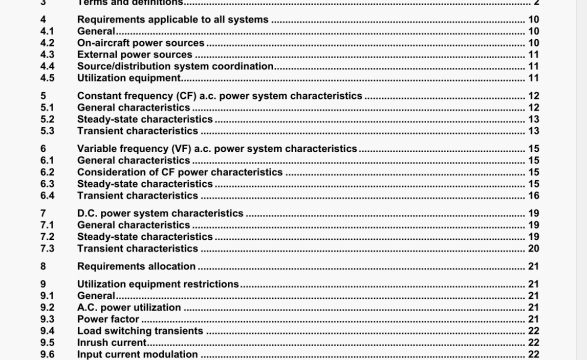ISO 01540 pdf download – Aerospace – Characteristics of aircraft electrical systems.
Ublization equipment shall preferably use only one poWer type (a.c. or dc.). Equipment that uses multile power types shall provide its specified performance when subjected to simultaneous variations and singular interruptions of each power input within the limits described in this International Standard
The wiring ci return currents shall be carried out as follows:
— no point of equment internal wiring shall be bonded to its casing: and
— aN connections to neutral or negative (d.c.) shal be separately brought out from the equment before being connected to the structure or ground.
Th. casing shall be bonded to the aircraft structure by an independent connection. The details of application shall be Ii accordance with the applicable standards In the areas of Witerference elimination and bonding.
4&3 Power supply interruptions
The loss of power (ac. or d.c.) or the loss of one or more phases of a.c. power to any utilization equipment terminal, however repetitive, shall not result in an unsafe condition or damage to utilization equipment. Equipment performance In these events shall be as defined Vt the applicable utilization equipment specification for abnormal operation. AMowances for equipment re-initialization are expected in these crcumstances.
In the case of power supply interruptions, the voltage loss may be progressive, so-called transients of normal operation may follow the recovery voltage.
Micro-Interruptions or under voltages of variable duration may be seen as interruptions of supply by certain components. In this case, equipment comprising digital circuits and/or memory or sequential circuits shall be the subject of a self-test. (See ISO 7137.)
4.5.4 Power supply Input polarity
User equipment Is not required to operate, but shall not be damaged when the polarity of the input power it receives is incorrect. Direct current or single phase ac. user equipment shall accept reversal of power and return inputs without damage Three-phase user equipment shall accept either incorrect phase sequence (A-B-C) or a momentary condition of a missing phase without damage.
5 Constant frequency (CF) a.c. power system characteristics
5.1 General characteristics
The characteristics below apply to the power at the utilization equipment terminals unless otherwise stated. They have been determined to be suitable for general application. Equipment designed to these characteristics should therefore find ease of compatibility with a wide variety of power sources and airaft. These characteristics apply to 26 V. 115/200 V and 2301400 V s.c. systems that utilize nominal 400 Hz power generated by rotating or static sources. Voltage differences between the various systems are accommodated within Table 1.
The voltage characteristics apply to line-to-neutral (L-N) quantities: line-to-line (L-L) characteristics should be as a result of the L-N values being as shown.
NOTE AJ ac. voltage values are rms values isess otherA4se slated. Steady-state Sc. voltages are the time average of the respective voltage values over a time period of between 0.2 a and 1 s. Peak voltages are the maximian instantaneous value of the voltage wavelorm
6.3.5 Voltage modulatIon
The modulation of phase voltages shall not exceed the limits of Table 2 (narrow-range VF) or Table 3 (wide-range VF) when measxed as the peak-to-valley difference between the maximum and minimum peak voltages reached on the modulation envelope over a perIod of at least one second. Frequency components of modulation shall be within the limits of Figure 3.
6.3.6 Voltage waveform characte.lstlcs
The voltage supplied to utilization equipment shall maintain the blowing waveform characteristics for any phase voltage:
the crest factor is within the limits of Table 2 for narrow-range VF and Table 3 for wide-range VF;
the voltage distortion factor does not exceed the limit specified in Table 2 for narrow•range VF and Table 3 for wide-range VF;
— the individual frequency components of distortion, which do not mdude the fundamental, do not exceed the limits of Figure 4;
— the d.c. content of the voltage waveform is within the limits of Table 2 for narrow-r1ge VF and Table 3 for wide-range VF
6.3.7 Frequency
In VF systems, the men, enne-dnven generators of the primary power system do not regulate the frequency of the ac. voltage; instead, this frequency varies while tracicing (through a ratio) the engine speed, Since the selected frequency range overlaps that expected of external and auxiliary power sources, all VF system frequency requwements are a direct result of the pedicted engine speed performance.
Therefore, the steady-state frequency characteristics of the power supplied to VF equipment shall be within the limits defined in Table 2 for narrow-range VF and Table 3 for wide-range VF.
6.4 TransIent characteristIcs
6.4.1 Voltage transients
Transient voltages shall remain with the limits of Figure 8 for normal operating conditions, which includes normal power transfers between sources and changes in load demand such as motor starts. Transient voltages shall remain within the limits of Flgise 7 during abnormal operating conditions, which Include the response of the power system because of system faults.
ISO 01540 pdf download – Aerospace – Characteristics of aircraft electrical systems
